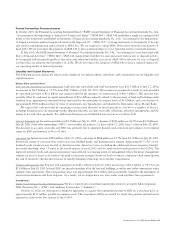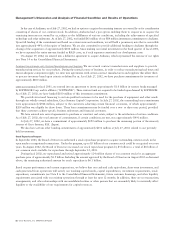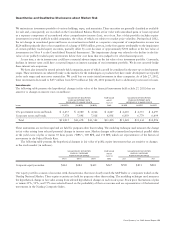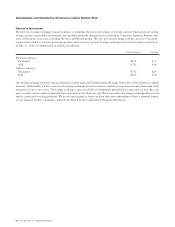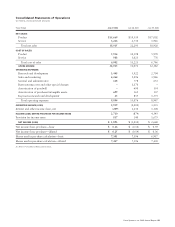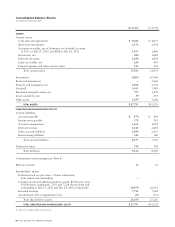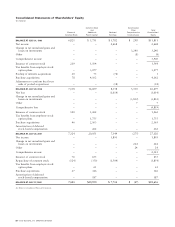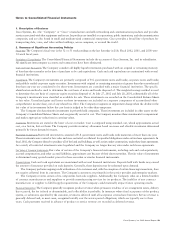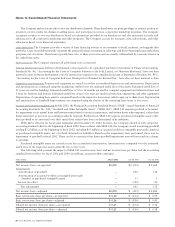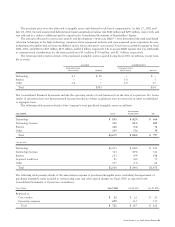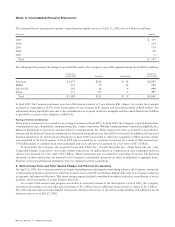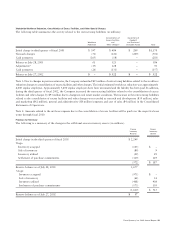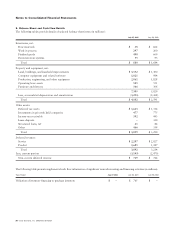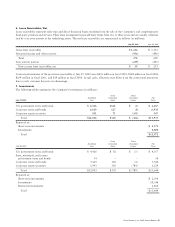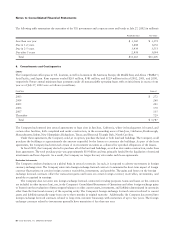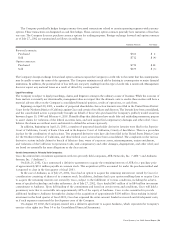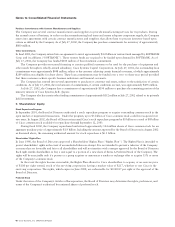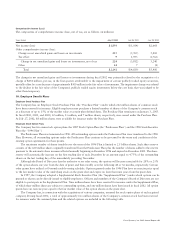Cisco 2002 Annual Report Download - page 33
Download and view the complete annual report
Please find page 33 of the 2002 Cisco annual report below. You can navigate through the pages in the report by either clicking on the pages listed below, or by using the keyword search tool below to find specific information within the annual report.
Cisco Systems, Inc. 2002 Annual Report 31
Income Taxes Income tax expense is based on pre-tax financial accounting income. Deferred tax assets and liabilities are recognized
for the expected tax consequences of temporary differences between the tax bases of assets and liabilities and their reported amounts.
Computation of Net Income (Loss) per Share Basic net income (loss) per share is computed using the weighted-average number of common
shares outstanding during the period. Diluted net income per share is computed using the weighted-average number of common shares
and dilutive potential common shares outstanding during the period. Diluted net loss per share is computed using the weighted-average
number of common shares and excludes dilutive potential common shares outstanding, as their effect is antidilutive. Dilutive potential
common shares consist of employee stock options and restricted common stock.
Foreign Currency Translation Assets and liabilities of non-U.S. subsidiaries that operate in a local currency environment are translated to U.S.
dollars at exchange rates in effect at the balance sheet date with the resulting translation adjustments directly recorded as a separate
component of accumulated other comprehensive income (loss). Income and expense accounts are translated at average exchange
rates during the year. Where the U.S. dollar is the functional currency, translation adjustments are recorded in other income (loss).
Derivatives The Company recognizes derivatives as either assets or liabilities on the Consolidated Balance Sheets and measures those
instruments at fair value. The accounting for changes in the fair value of a derivative depends on the intended use of the derivative
and the resulting designation.
For a derivative designated as a fair value hedge, the gain or loss is recognized in earnings in the period of change together
with the offsetting loss or gain on the hedged item attributed to the risk being hedged. For a derivative designated as a cash flow
hedge, the effective portion of the derivative’s gain or loss is initially reported as a component of accumulated other comprehensive
income (loss) and subsequently reclassified into earnings when the hedged exposure affects earnings. The ineffective portion of
the gain or loss is reported in earnings immediately.
The Company uses derivatives to manage exposures to foreign currency and securities price risk. The Company’s objective
for holding derivatives is to minimize the volatility of earnings and cash flows associated with changes in foreign currency and
security prices.
Certain forecasted transactions and foreign currency assets and liabilities expose the Company to foreign currency risk. The
Company purchases currency options and designates these currency options as cash flow hedges of foreign currency forecasted
transactions related to certain operating expenses. The Company enters into foreign exchange forward contracts to minimize the
short-term impact of currency fluctuations on certain foreign currency receivables, investments, and payables. The foreign exchange
forward contracts are not designated as accounting hedges and all changes in fair value are recognized in earnings in the period
of change.
The fair value of derivative instruments as of July 27, 2002 and changes in fair value during fiscal 2002 were not material.
During fiscal 2002, there were no significant gains or losses recognized in earnings for hedge ineffectiveness. The Company did
not discontinue any hedges because it was probable that the original forecasted transaction would not occur.
Minority Interest Minority interest represents the preferred stockholders’ proportionate share of the equity of Cisco Systems, K.K.
(Japan). At July 27, 2002, the Company owned all issued and outstanding common stock amounting to 92.4% of the voting
rights. Each share of preferred stock is convertible into one share of common stock at any time at the option of the holder.
Use of Estimates The preparation of financial statements and related disclosures in conformity with accounting principles generally accepted
in the United States requires management to make estimates and assumptions that affect the amounts reported in the Consolidated
Financial Statements and accompanying notes. Estimates are used for, but not limited to, the accounting for the allowance for
doubtful accounts and sales returns, inventory allowances, warranty costs, investment impairments, goodwill impairments,
contingencies, restructuring costs and other special charges, and taxes. Actual results could differ materially from these estimates.
Impairment of Long-Lived Assets Long-lived assets and certain identifiable intangible assets to be held and used are reviewed for
impairment whenever events or changes in circumstances indicate that the carrying amount of such assets may not be recoverable.
Determination of recoverability is based on an estimate of undiscounted future cash flows resulting from the use of the asset
and its eventual disposition. Measurement of an impairment loss for long-lived assets and certain identifiable intangible assets
that management expects to hold and use is based on the fair value of the asset. Long-lived assets and certain identifiable intangible
assets to be disposed of are reported at the lower of carrying amount or fair value less costs to sell.
Recent Accounting Pronouncements In October 2001, the FASB issued Statement of Financial Accounting Standards No. 144, “Accounting
for the Impairment or Disposal of Long-Lived Assets” (“SFAS 144”). SFAS 144 establishes a single accounting model, based on
the framework established in Statement of Financial Accounting Standards No. 121, “Accounting for the Impairment of Long-Lived
Assets and for Long-Lived Assets to Be Disposed Of” (“SFAS 121”), for long-lived assets to be disposed of by sale, and resolves
implementation issues related to SFAS 121. The Company is required to adopt SFAS 144 no later than the first quarter of fiscal 2003.
The Company does not expect the adoption of SFAS 144 to have a material impact on its operating results or financial position.


